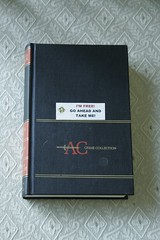4 – The Man in the Brown Suit (1924)
Featuring: Anne Beddingfield, Colonel Race
 TANSY SAYS:
TANSY SAYS:This is another of those books which actually isn’t a classic murder mystery – or what we think of, I guess, when we say ‘Agatha Christie mystery’. It’s another of those adventure-spy-flapper-thriller-romances like The Secret Adversary. I rather like them – suspense without all that dreary grit and manly upper lip. Can we call them jollysuspenses?
I like Anne as a narrator a lot, and it’s a little sad that this is her only outing. I did however, adore Colonel Race with a fiery passion, and I’m not sure I can forgive her for running off and marrying that weird passive aggressive ‘hero’ instead. All this might have something to do with the fact that whenever I read ‘Colonel Race’ my brain substituted ‘Colonel Brandon’ and so all I could see was Alan Rickman in Sense & Sensibility. Who, by the way? GOT THE GIRL. Still, apparently there is much Colonel Race to come. Here’s hoping he gets his own romance at some point.
Anne is definitely of the Tuppence mould of heroines – a girl on her own who goes out in search of Adventure. I loved the fact that she was obviously educated, smart and literate (with a fine vocabulary) and yet also quite endearingly dumb as a stone. The idea of spending her entire inheritance on a random cruise ship to South Africa in the hope of solving a crime is audacious and I liked her from that moment.
Also, and this is hugely spoilery, so beware, but the use of the dual narrative with the diaries of Sir Eustace Pedlar was incredibly well done. Nothing in the diaries were lies (well I don’t think so, but I wasn’t committed enough to go back and check), but there was a lot omitted, including of course the fact that he was totally the villain of the story. I think Anne’s obvious sympathy for him (which is honest) and the fact that he gave her permission to use those diary entries were really good touches that allowed Christie to get away with the trick. And of course this is her flirting with the idea that I believe will be important later on – making the murderer the least likely person, and even the narrator himself.
Mrs Blair was a great supporting character – I liked her a lot, and got a kick out of the fact that in the 1980’s movie, she was played by Rue McClanahan. Great casting!
The plot was of course very complex. I found myself a lot less interested once we got off the ship – that was the setting that most appealed to me, and I missed it when we hopped off at the other end. My favourite twist in the tale was the many identities of Chichester/Pettigrew/Minks, particularly how the running joke of Sir Eustace wanting a pretty secretary was turned into a key plot device. Sir Eustace himself is an excellent villain, especially because things he said when we thought he was a lovable buffoon suddenly take on this hugely sinister edge when we realise the truth – and because he is exactly the same character before and after the reveal.
KATHRYN SAYS:
I’m not sure I love Anne Bedingfield as much as I loved Tuppence, but I certainly ADMIRE someone who will spend the entirety of their measley inheritance on a one way ticket to Cape Town**. Freak’n A. I am someone who as yet has never travelled anywhere without all my accommodation being sorted, let alone across the world with no extra money! Anyway, I digress. I feel like I’m starting to feel a repetitive by saying that once again we do not have a typical Agatha Christie novel. True, we’re only at book 4. Is she still finding her way? Do I have serious misconceptions about what an Agatha Christie novel actually involves?
I did love the structure of this book with excerpts of Sir Eustace’s diary interspersed with Anne’s narrative and, as Tansy has pointed out, it hints at some of the future narrative structures that Christie uses to shield her murderer. To me, this book has three definite stages, or acts: the prelude in London, hijinks on the ship and then a rather dashing section in Africa. I felt the most focussed section of the story was the ship hijinks, but the section in Africa also intrigued me. Yes, it is rather fractured – people heading off in cars and trains and doubling back, kidnapping, and stops for ice cream sodas along the way. However once everyone settles, there is some really interesting description of scenery from Cape Town to Rhodesia, and then again of riots in Johannesburg. I did wonder if Christie write this from first hand knowledge, and according to Wikipedia (yay) the book does have some parallels to incidents and settings of a round-the-world work trip taken by Christie with her first husband, Archie Christie, in 1922. Perhaps this is why this book was written when it was. Again this Christie novel ends with LOVE, however it is not as satisfactory as previous outings. Anne’s love interest is perhaps a bit too manly and tortured for my liking – where’s the fun in that?
**First Class ticket, mind you – though I do appreciate a young woman travelling alone could probably have not gone second class in 1924!
COMING SOON
Poirot Investigates (1924)
Short Stories.
5. The Secret of Chimneys (1925)
Anthony Cade, Superintendent Battle
6. The Murder of Roger Ackroyd (1926)
Hercule Poirot